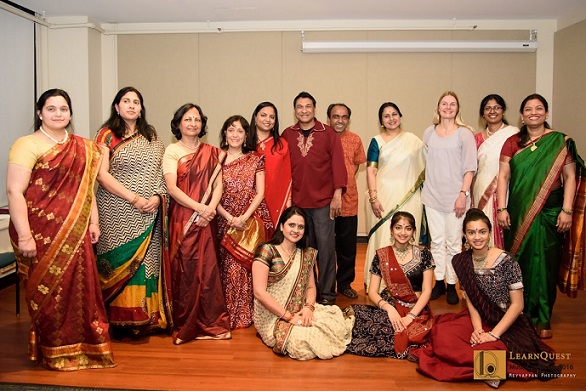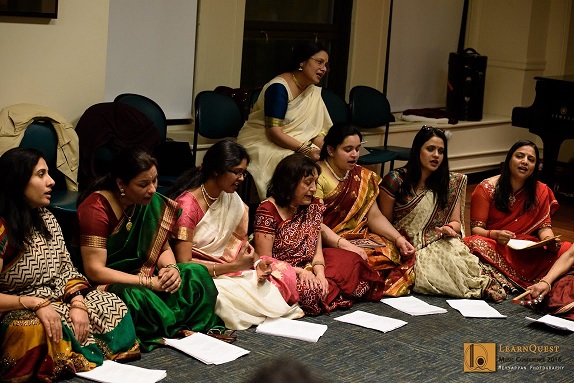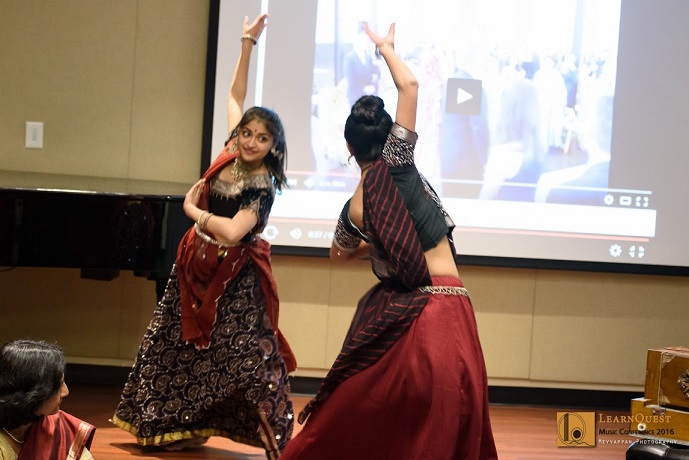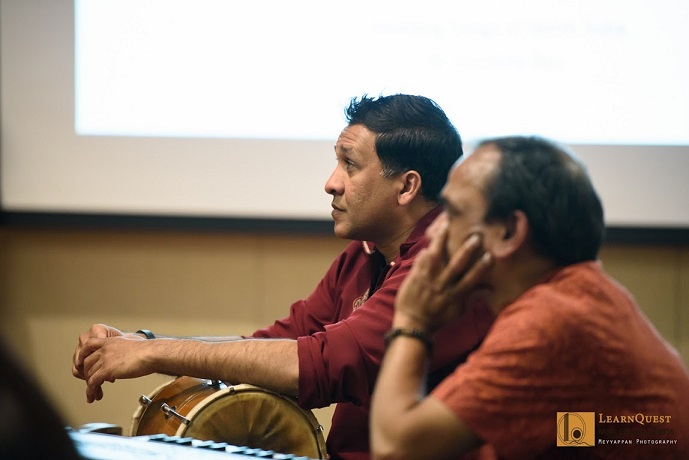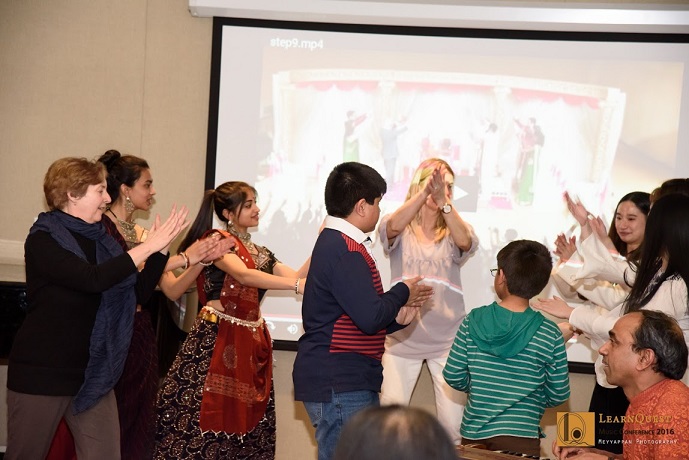Contribute
| North Indian Wedding Songs: LearnQuest Music Program Held At Boston University |
Donna Maurer, Ph.D.
03/31/2016
In North Indian weddings, a wide variety of vibrant colors,
sights, flavors, and of course, sounds enliven the senses. Such a vivid sensory
experience draws attention to and heightens the significance of weddings not
just for those getting married, but also for their families and honored guests.
As a key element of the experience, music threads through the entire set of
wedding rituals, which can last for up to a week. The traditional songs, many
of which are often passed on from one generation to the next, are melodious,
energizing, and culturally rich; thus these songs deserve to be heard,
appreciated, and preserved. On Wednesday, March 23, talented Hindustani vocalist Smt. Shuchita
Rao and her accompanying musicians, dancers, and student singers treated their
audience to a wonderful educational and musical experience around the theme of
North Indian wedding songs, as part of the five-day LearnQuest Academy of Music
Conference; this event was held in collaboration with Boston University. After being introduced by Dr. Pradeep Shukla, Director of
LearnQuest Academy of Music, Shuchita meaningfully set the stage for the
program, which featured a diverse audience with various levels of understanding
and experience of the music and culture of India, by drawing on the ideas of
anthropologist Victor Turner. As Turner had pointed out, wedding rituals serve as a rite
of passage. When a person moves from one status to another, during the
transition, there is a temporary state of chaos (liminality); rituals help
smooth this temporarily uncomfortable transition period. Music, then, has not
only an aesthetic function, but also a practical one: It can help re-orient all
of the individuals involved as the couple moves from being daughter and son to
becoming wife and husband. In particular, folk traditions were built around the
practice of arranged marriages, and thus it was especially crucial to bridge
the uncertainty associated with the new relationship, especially for the bride
and groom, but also for their families. After presenting this thoughtful groundwork for the program,
Shuchita and her team led their audience members on a vibrant musical and
multimedia journey through the various phases of the complex set of wedding
rituals – 13 such phases altogether! Video
segments of the various rituals provided a vivid backdrop for the team’s
emotive singing. Some highlights included group songs, such as Mehendi Hai Rachne Waali, to celebrate
the pre-wedding ritual where women in both the bride’s and groom’s families
come together to apply beautiful henna tattoo designs to their hands. Here, the
audience really had a great sense of the festivities, with the joyful singing
of the group, which included Shuchita’s singing students: Alka Pandey,
Chaitrali Yadav, Meenakshi Rana, Lavanya Kancharla, Chandra Ganapathy, Swapna
Kommidi, Rekha Jugulum, Pallavi Mehta, and Satya Rao. The melody and
rhythm were well accentuated by the skilled accompaniments of Sri Mohitosh
Talukdar Taposh on harmonium and Sri Vijay Mohan on dholak. The audience also was thrilled by Shuchita Rao’s sweet and
emotive solo singing. One lovely melody was Nazariya
Lag Jayegi Hariyaale Ko Koi Mat Dekho, which Shuchita explained, referred
to the idea that one should “not stare at the bridegroom who looks handsome in
his gold ornaments and expensive clothes.†This song is sung during the Haldi
(turmeric) ritual, when the bride and groom are kept separately at their
parents’ homes, and turmeric is applied for its cooling and healing properties.
Sacred aspects are also featured in some of the wedding
rituals, and the music reflects the solemn aspects of the experience through
the recitation of sacred chants. One of Shuchita’s students, Satya Rao, chanted
some of these Sanskrit mantras, including one to accompany the offering to
"Agni," the God of fire, who is considered a key witness to the union
of bride and groom during the Hindu wedding ceremony. Other songs, such as Aanand Kar Naachat Hai Ganpathy and Aaya Mangal Din Aaj, mark the auspiciousness of the wedding day; the
group’s performance of this latter song featured the delightful and exuberant
dancing of Minerva Teli and Radha Rao. The audience clearly enjoyed the program, with some even
taking part in the Garba Dance celebrating the married couple’s arrival at the
husband’s family home, with the song Mai
Tho Bhool Chali Babul Ka Desh. Thus even the audience members, including Professor Brita
Heimarck of Boston University's Ethnomusicology department and several of her
music students from Southern China, had
a chance to directly experience the joy and musicality of the wedding celebration.
As a member of the audience, Mr. Larry O’Toole, Director of Technology at
Boston University, commented, I was thoroughly charmed by the
music and dance that [Shuchita and her] students demonstrated. . . . There is
such a range of emotion that is present in any wedding, but especially, as in
the arranged marriage tradition, when bride and groom are just discovering each
other for the first time as part of the ceremony. Song and dance can
certainly help the individuals and families get through these changes and come
out happier on the other end. Surely, music brings families together to celebrate
the new relationship and the new connection between the bride’s and groom’s
families, and Shuchita and her team well captured the musical colors and
flavors of wedding rituals. This LearnQuest program was an excellent
opportunity for attendees to experience traditional songs in a way that brought
forth all the love, joy, solemnity, and passion associated with wedding rituals
in North India!
You may also access this article through our web-site http://www.lokvani.com/
